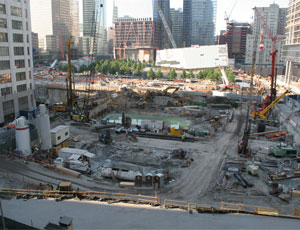After the prosecution wrapped its case on June 1 after nearly two months of argument in the manslaughter trial of three New York City construction managers for a fatal Manhattan building fire in 2007, defense attorneys insisted a reasonable jury could not blame their clients.

State Supreme Court Justice Rena K. Uviller conceded the defense raised “very important issues” in its June 2 motion to toss criminal charges against their clients—Jeffrey Melofchik, Mitchel Alvo and Salvatore DePaola and subcontractor John Galt Corp.—who are being prosecuted for the fire at the Deutsche Bank.
However, just as she did before the trial began in March, Uviller refused to dismiss the charges before the defense put on its case. The charges include 20 counts of criminally negligent homicide, second-degree manslaughter and reckless endangerment. Melofchik was site manager for project contractor Bovis Lend Lease; Alvo and DePaola worked for Galt.
Prosecutors argued that the managers had recklessly cut out a 42-ft section of a building standpipe to save millions of dollars and speed asbestos abatement and demolition. The 40-story building, next to the former World Trade Center, was damaged in the Sept. 11, 2001, terrorist attack. The seven-alarm blaze on the 17th floor killed firefighters Robert Beddia and James Graffagnino. Demolition was finally completed earlier this year.
Instead of reaching the floors where at least 100-plus firefighters were stranded, water escaped into the basement. But Melofchik attorney Edward Little said prosecutors did not prove that his client cut off the water supply or even that water would have helped the trapped firefighters.
Firefighters testified otherwise, but Little said they were not expert witnesses and their testimony should be dismissed as “speculative.” Claiming firefighters often work in “blackout conditions” similar to those in the bank fire, prosecutor Joel Seidemann mocked that line of argument. “Mr. Little should be free to argue that water has nothing to do with putting out a fire,” he said. “It’s a jury question.”
The first defense expert witness, a fire- protection engineer and former firefighter, was called to explain Little’s counterintuitive contention. Craig Beyler said he designed a computer model of the construction site based largely on prosecution evidence. He then led jurors through the model, aiming a laser pointer at dozens of fans that he said made up the building’s “negative air system” used in abatement. The defense believes that, when the fire ignited, the system created a “smoke chamber” that suffocated the firefighters and pulled the smoke down in a way that destroyed visibility.
Little said that even if the breached pipe was the only thing standing between the firefighters and their lives, prosecutors did not prove Melofchik cut it. Five witnesses called to support that contention gave testimony that was “all over the map,” Little said. An attorney for Alvo said prosecutors produced “no admissible evidence” that he ordered the pipe cut.But Seidemann said Alvo’s denial of such orders was a “self-serving lie.”
Defense attorneys also said prosecutors failed to show their clients had a legal duty to keep the standpipe functioning. Nothing in the city building code, project contracts or verbal orders made clear that the managers were responsible, attorneys claimed. Defense attorneys believe city agencies and inspectors were tasked with the pipe’s inspection and upkeep. However, prosecutors said the defendants’ job responsibilities still went beyond contracts and codes. “It was a very dangerous job site,” Seidemann said.

Post a comment to this article
Report Abusive Comment